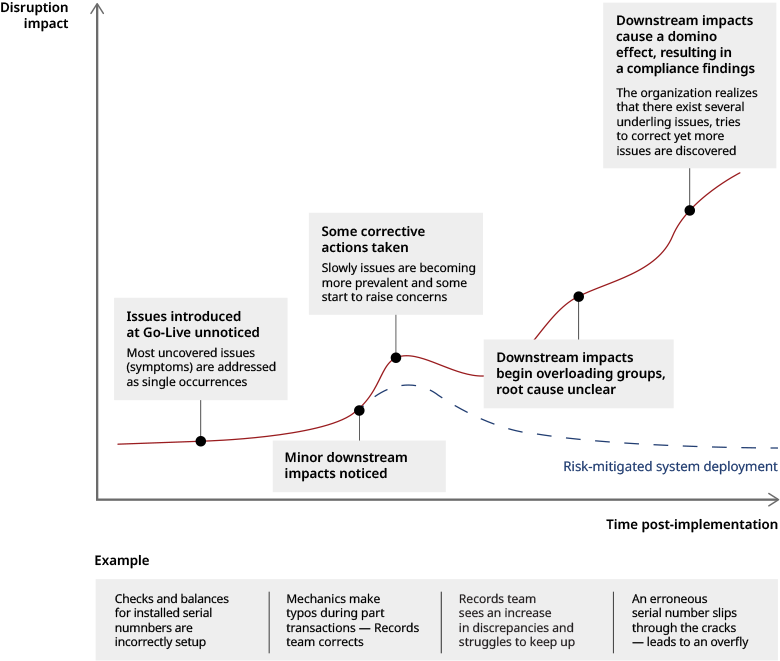Many carriers are either well on the way to modernizing their MRO IT systems or have recently done so. They have committed to this task in the expectation that it will achieve significant operational, cost, and compliance benefits.
All too frequently, not everything goes to plan. After a lengthy, costly, and often organizationally exhausting implementation , a fair number of carriers find themselves struggling to realize the value promised. Instead, they continue to fight fires and manage systems-related disruptions.
The perils of the post-implementation stabilization journey
The typical post-implementation journey for most carriers is depicted in the figure below. Immediately after cutover, the carrier experiences some expected and unexpected disruptions that are usually related to training and process adherence. At this point, the carrier remains engaged in post-cutover stabilization, so the disruptions are managed and addressed on a case-by-case basis without raising much organizational concern.
Things begin to change, however, typically at around the 3-6-month mark, as the organization starts to use the data accumulated in the system. Minor impacts are noticed downstream. Some within the organization raise concerns as the first of a new set of symptoms start to surface. At this point, expectations have been set that the post-cutover stabilization is over. Usually, departments begin engaging with the solution vendors to help troubleshoot the problems or ask for more detail reporting to understand the source of the discrepancies.

Because these problems have been left unchecked until this point, data discrepancies and other operational issues are likely to continue to grow and can start impacting the organization’s compliance and performance (see figure).
Temporary manual processes that have earlier been set in place to address these issues can also have the inadvertent effect of overloading organizational resources, even as further issues are uncovered. This is the tipping point, which leads most organizations to seek external support, both to better understand the problem, fix the underlying causes, and augment staff in order to correct all the known issues.
The most common pitfalls in MRO IT system implementation
While this might be the typical post-deployment journey, it doesn’t have to be. It is important for key stakeholders to understand the risks of a new implementation ahead of deployment. We can categorize these risks based on processes, people, data quality and governance, and configuration setup.
Processes: Carriers spend significant amounts of time upfront defining their “desired” future state processes and translating these into requirements, only to see some of these requirements chipped away during implementation. A lot of these requirements are de-scoped and fall off the “MVP” list, with the promise that they will be realized later. Operators, meanwhile, tend to forget about future enhancements, such as electronic signatures, e-logbooks, and innovative business analytics. It shouldn’t come as too much of a surprise that if functionality falls off the implementation and enhancements list that system performance will likewise fall short of expectations.
If the realization of functionality requirements is not managed carefully, at cutover, the organization may be faced with broken and ineffective workflows. These workflows require manual workarounds and typically lack the necessary controls, validation steps, and associated reporting. Such workarounds, while necessary, are often inefficient and are not always embedded accurately in the maintenance manuals, leaving the organization exposed to compliance issues.
People: Often, leaders have a false sense of security, believing that their organization has collected sufficient system expertise and know-how about the new MRO IT system during the prolonged implementation period. Sadly, this is often not the case, as most of the resources have worked in activities such as data cleansing, user acceptance testing (UAT), migration, training, etc. – with little exposure to the system in actual operation. The resulting lack of first-hand user expertise, coupled with insufficient or ill-timed training often has a significant impact on adoption and can exacerbate some of the user-introduced errors.
Data quality and governance: Migrations are never perfect and some incorrect and incomplete data will always be brought into the new system. Although imperfect data in the legacy system might not cause issues, this is not the case in a modern MRO IT system with tighter data quality controls. The data discrepancies will decrease system performance and create frustration and distrust among users. Most importantly, data discrepancies brought over during migration can mask more serious misalignments with users, processes, and system configuration.
Configuration setup:As with any brand-new software, most MRO IT systems come with a default out-of-the-box configuration. Configuration settings affect user permissions, validation prompts, user alerts, and other functional aspects. If not fully understood and fine-tuned to match the organization’s operational needs, the installed configuration can lead to many surprises during deployment.
The issues described here occur during all too many implementations. Carriers almost always find that it takes more time than they expect to fully stabilize and optimize their processes and data so that they can leverage their MRO IT systems effectively. Though, these challenges can be overcome. In the second part of this series, we will discuss the actions and other best practices that carriers can take to mitigate these risks, smooth out implementation, and accelerate the extraction of value.

